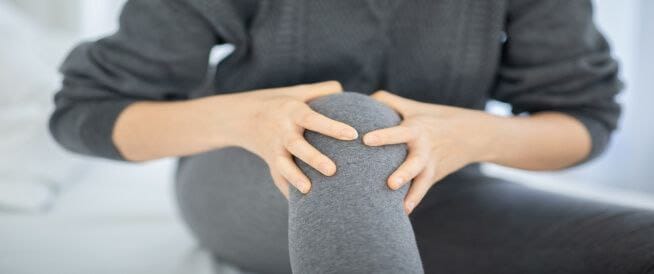And tips for how to ease the hurt
It’s an unpleasant feeling: You’ve been on your feet all day or maybe you’ve had a big workout or a long run. You try to go to bed to rest up, but you can’t fall asleep. The culprit? Knee pain.
Knee pain at night can be incredibly frustrating, especially because you likely didn’t notice any sort of discomfort during the day. It’s only after you lay down for slumber that it feels like it surges forward to keep you awake and cut into your sleep.
What causes the pain?
Knee pain can be caused by a variety of issues, from injury to tendonitis (irritation of tendons) to bursitis (irritation of bursa sacs that cushion your bones and joints). But the primary cause of knee pain is usually a form of arthritis.
People with normal, healthy knees usually don’t get pain at night. There’s typically a reason, and it’s often because they have arthritis, commonly osteoarthritis.
Osteoarthritis is mechanical in nature, caused by wear-and-tear on the joints as well as the cartilage and tendons associated with the joints. This sets the condition apart from rheumatoid arthritis which is inflammation of the joints, typically caused by an overactive immune system.
While osteoarthritis is typically seen in older patients, it can occur in younger patients, too, particularly those who are prone to overuse of certain joints or suffered significant injuries like ligament tears.
Why at night?
While activity during the day contributes to the pain you feel in your knees at night, so does the fact that you’ve actually slowed down enough to notice.
When you’re moving your joints, they’re also staying lubricated. When you’re not moving, they don’t lubricate as much.
Another reason you start noticing the pain? You’re not as distracted by everything else.You don’t have any other distractions around you. It’s quiet and you’re laying still, so you start to notice the discomfort. The lack of movement, the lack of lubrication, it all catches up with you.
How to treat it
Treating this knee pain is all about pain management and what you can do to reduce the stress on those joints. Losing weight is a helpful start. Besides being a key to overall good health, cutting excess pounds lessens the everyday stress on those knee joints and ligaments.
But there are plenty of other ways, too.
Exercise smart
A lot of joint stress is caused by high-impact exercising, especially running on pavement. But there are ways to exercise that can keep you healthy and keep that load off your knee joints. “Low-impact exercises like swimming, bicycling and elliptical are good because they exercise the knee joints but don’t pound them,.
Knee braces can also be a tool. There are special braces that work to keep pressure off of certain parts of the knee — unloader braces — that can sometimes help alleviate arthritis pain.
Medication
If you’re considering over-the-counter (OTC) painkillers to help ease the hurtit’s best to take naproxen (Aleve) or ibuprofen (Advil) because they have anti-inflammatory properties that can help ease the swelling that’s causing your knee pain.
Acetaminophen medications, like Tylenol, don’t work as well because they mask the pain but do nothing about the source of the pain.
taking the dose after dinner as that allows you to have the maximum dose before you head to bed.
Just be careful: If you’re on any blood-thinner medication, you’ll have to stick to Tylenol or possibly another painkiller prescribed by your doctor because interaction with those anti-inflammatory meds might have dangerous side effects, including internal bleeding. Be sure to check with your healthcare provider to make sure you pick the one that’s best for you.
Cold versus heat
Cold treatment, like ice, can dull pain while heat on injuries can also make a painful joint feel better. The key, though, is to use both. Using heat on the sore joint will certainly make it feel better, but it will also increase blood flow to the area. That will eventually leave it more swollen and throbbing.
Instead, he suggests using heat for the initial relief but then switching to cold treatment like ice. The warmth helps the joint feel better but follow that with cold so the blood doesn’t pool there.
Topical gels can also help. There are prescription gels, OTC gels like IcyHot or Bengay and even anti-inflammatory patches that help bring relief for those painful joints.
Again, though, you’ll want to consult with your healthcare provider before going this route to make sure you maximize the treatment and avoid any side effects or additional issues.
How to sleep comfortably
Finally, you can adjust your position in bed to ensure cutting down on that discomfort and getting more sleep.
Sometimes, if you have arthritic knees, we suggest sleeping on your side with a small pillow between your knees, The position gives more support and keeps your knees from knocking together.
If you’re a back-sleeper trying to sleep with a pillow under your knees. Besides offering support, this keeps your knees slightly bent which can keep bones from pressing together at the worn-down, painful joint.
It’s really about finding the position of comfort and using a pillow for cushioning that feels best for you,





